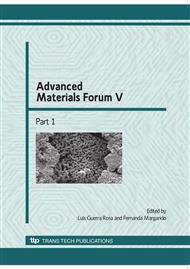[1]
Tokaji, K., Effect of stress ratio on fatigue behaviour in SiC particulate-reinforced aluminium alloy composite, Fatigue Fract. Eng. Mater. Struct. 28, 539-545.
DOI: 10.1111/j.1460-2695.2005.00894.x
Google Scholar
[2]
Lopez, V.H., Scoles, A., Kennedy, A.R., The thermal stability of TiC particles in an Al7wt. %Si alloy, Mater. Sci. & Eng. A356 (2003) 316-325.
DOI: 10.1016/s0921-5093(03)00143-6
Google Scholar
[3]
Khan, K.B., Kutty, T.R.G., Surappa, M.K., Hot hardness and indentation creep study on Al- 5% Mg alloy matrix-B4C particle reinforced composites, Mater. Sci. & Eng. A 427 (2006) 76-82.
DOI: 10.1016/j.msea.2006.04.015
Google Scholar
[4]
Lee, K.B., Ahn, J.P., Kwon, H., Characteristics of AA6061/BN composite fabricated by pressureless infiltration technique, Metall. Mater. Trans. A 32A (2001) (4), 1007-1018.
DOI: 10.1007/s11661-001-0358-5
Google Scholar
[5]
Kerti, I., Toptan, F., Microstructural variations in cast B4C-reinforced aluminium matrix composites (AMCs), Mater. Lett. 62 (2008) 1215-1218.
DOI: 10.1016/j.matlet.2007.08.015
Google Scholar
[6]
Ipek, R., Adhesive wear behaviour of B4C and SiC reinforced 4147 Al matrix composites (Al/B4C-Al/SiC), J. Mater. Procng. Technol. 162-163 (2005) 71-75.
DOI: 10.1016/j.jmatprotec.2005.02.207
Google Scholar
[7]
Bedir, F., Characteristic properties of Al-Cu-SiCp and Al-Cu-B4Cp composites produced by hot pressing method under nitrogen atmosphere, Mater. & Design 28 (2007) 1238-1244.
DOI: 10.1016/j.matdes.2006.01.003
Google Scholar
[8]
Kalkanli, A., Yılmaz, S., Synthesis and characterization of aluminum alloy 7075 reinforced with silicon carbide particulates, Mater. & Design 29 (2008) 775-780.
DOI: 10.1016/j.matdes.2007.01.007
Google Scholar
[9]
Kerti, I. , Production of TiC reinforced-aluminum composites with the addition of elemental carbon, Mater. Lett. 59 (2005) 3795-3800.
DOI: 10.1016/j.matlet.2005.06.032
Google Scholar
[10]
Zhang, H., Ramesh, K. T., Chin, E.S.C., High Strain Rate Response of Aluminium 6092/B4C Composites, Mater. Sci. and Eng., A 384 (2004) 26-34.
DOI: 10.1016/j.msea.2004.05.027
Google Scholar
[11]
Aizenshtein, M., Froumin, N., Shapiro-Tsoref, E., Dariel, M.P., Frage, N., Wetting and interface phenomena in the B4C/(Cu-B-Si) system, Scripta Mater. 53 (2005) 1231-1235.
DOI: 10.1016/j.scriptamat.2005.08.006
Google Scholar
[12]
Jung, J., Kang, S., Advances in Manufacturing Boron Carbide-Aluminum Composites, J. Am. Ceram. Soc., 87.
Google Scholar
[1]
47-54 (2004).
Google Scholar
[13]
Zhu, X., Dong, H., Lu, K., Coating different thickness nickel-boron nanolayers onto boron carbide particles, Surf. & Coat. Technol. 202 (2008) 2927-2934.
DOI: 10.1016/j.surfcoat.2007.10.021
Google Scholar
[14]
Shrestha, N.K., Kawai, M., Saji, T., Co-deposition of B4C particles and nickel under the influence of a redox-active surfactant and anti-wear property of the coatings, Surf. & Coat. Technol. 200 (2005) 2414- 2419.
DOI: 10.1016/j.surfcoat.2004.08.192
Google Scholar
[15]
Zhang, Z., Chen, X. -G., Charette, A., Particle distribution and interfacial reactions of Al- 7%Si-10%B4C die casting composite, J. Mater. Sci. (2007) 42: 7354-7362.
DOI: 10.1007/s10853-007-1554-5
Google Scholar
[16]
Shorowordi, K.M., Laoui, T., Haseeb, A. S. M. A., Celis, J. P., Froyen, L., Microstructure and interface characteristics of B4C, SiC and Al2O3 reinforced Al matrix composites: a comparative study, J. Mater. Procng. Technol. 142 (2003) 738-743.
DOI: 10.1016/s0924-0136(03)00815-x
Google Scholar
[17]
Kennedy, A.R., Brampton, B., The Reactive Wetting and Incorporation of B4C Particles into Molten Aluminium, Scripta Mater., 44 (2001)1077-1082.
DOI: 10.1016/s1359-6462(01)00658-3
Google Scholar
[18]
Halverson, D.C., Pyzik, A.J., Aksay, I.A., Snowden, W.E., Processing of Boron CarbideAluminum Composites, J. Am. Ceram. Soc., 72.
Google Scholar
[5]
775-80 (1989).
Google Scholar
[19]
Kennedy, A.R., Karantzalis, A.E., The incorporation of ceramic particles in molten aluminium and the relationship to contact angle data, Mater. Sci. & Eng. A264 (1999) 122-129.
DOI: 10.1016/s0921-5093(98)01102-2
Google Scholar
[20]
D.C. Halverson, A.J. Pyzik, I.A. Aksay, Boron carbide aluminum and boron carbide-reactive metal cermets, US Patent no. 4, 605, 440, (1986).
Google Scholar
[21]
Toptan, F., Kilicarslan, A., Karaaslan, A., Cigdem, M., Kerti, I., Optimization of particle addition conditions in production of Al-B4C composites by casting route, 14th Int. Metall. & Mater. Cong., October 16th-18th, 2008 Istanbul (In Turkish).
Google Scholar
[22]
Shen, P., Zou, B., Jin, S., Jiang, Q., Reaction mechanism in self-propagating high temperature synthesis of TiC-TiB2/Al composites from an Al-Ti-B4C system, Mater. Sci. & Eng. A 454- 455 (2007) 300-309.
DOI: 10.1016/j.msea.2006.11.055
Google Scholar


